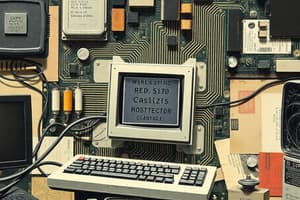Podcast
Questions and Answers
What is the primary purpose of interrupts in a computer system?
What is the primary purpose of interrupts in a computer system?
- To increase the processor speed
- To replace direct memory access controllers
- To slow down the processor
- To provide control for external I/O initiation (correct)
Direct Memory Access (DMA) involves the active involvement of the CPU in data transfer operations.
Direct Memory Access (DMA) involves the active involvement of the CPU in data transfer operations.
False (B)
State one primary advantage of using separate I/O controllers in a computer system.
State one primary advantage of using separate I/O controllers in a computer system.
Specialized control for a device
In programmed I/O, there is one word transfer per I/O ____________.
In programmed I/O, there is one word transfer per I/O ____________.
Match the following advanced I/O techniques with their descriptions:
Match the following advanced I/O techniques with their descriptions:
Flashcards are hidden until you start studying
Study Notes
Overview of Input/Output (I/O)
- I/O operations are crucial in computer systems, as they determine the processing speed or program execution
- The basic model of I/O involves input, processing, and output
I/O Requirements
- Means for addressing different peripheral devices
- A way for peripheral devices to initiate communication with the CPU
- Efficient means of transferring data directly between I/O and memory for large data transfers
- Buses that interconnect high-speed I/O devices with the computer must support high data transfer rates
- Capability of handling devices operating at varying speeds with varying delays
- Means for handling devices with extremely different control requirements
I/O Interfaces
- Necessary due to different formats required by devices, incompatibilities in speed, and bursts of data vs. streaming data
- Device control requirements that would tie up too much CPU time
Characteristics of Typical I/O Devices
- (No specific details provided in the text)
I/O Techniques
- Programmed I/O: CPU controlled I/O, where the CPU performs I/O operations using I/O instructions
- Interrupt Driven I/O: external input controls, where the CPU is interrupted by an I/O device to perform an I/O operation
- Direct Memory Access (DMA) Controllers: a method for transferring data between main memory and a device that bypasses the CPU
Programmed I/O
- Simplest method for performing I/O
- I/O data and address registers are in the CPU
- One word transfer per I/O instruction
- Address information is required for each I/O device
- Primary use: keyboards, communication with I/O controllers (see DMA)
Interrupts
- Signals that cause the CPU to alter its normal flow of instruction execution
- Frees the CPU from waiting for events
- Provides control for external I/O initiation
- Examples: unexpected input, abnormal situation, illegal instructions, multitasking, and multiprocessing
Interrupt Terminology
- Interrupt lines: special control lines to the CPU
- Interrupt request: a signal sent to the CPU to request an interrupt
- Interrupt handlers: programs that service interrupts, also known as interrupt routines or device drivers
- Context: saved registers of a program before control is transferred to the interrupt handler
Use of Interrupts
- Notify that an external event has occurred (real-time or time-sensitive)
- Signal completion (e.g., printer ready or buffer full)
- Allocate CPU time (time sharing)
- Indicate abnormal events (CPU originates for notification and recovery)
- Software interrupts
Servicing an Interrupt
- Lower priority interrupts are held until higher priority interrupts are complete
- Suspend program in progress
- Save context, including last instruction executed and data values in registers, in the PCB or the stack area in memory
- Branch to interrupt handler program
Direct Memory Access (DMA)
- Transferring large blocks of data
- Direct transfer to and from memory
- CPU not actively involved in transfer itself
- Required conditions for DMA: I/O interface and memory must be connected, I/O controller must be capable of reading and writing to memory, and conflicts between the CPU and I/O controller must be avoided
I/O Controllers
- Recognize messages from devices and accept commands from the CPU
- Provide a buffer for data transfer
- Provide necessary registers and controls for direct memory transfer
- Physically control the device
- Communicate with the CPU
Bus
- Physical connection for transferring data between locations in the computer system
- Group of electrical or optical conductors for carrying signals
- 4 kinds of signals: data, addressing, control signals, and power (sometimes)
Bus Characteristics
- Number of separate wires or conductors
- Data width in bits carried simultaneously
- Addressing capacity
- Lines on the bus are for a single type of signal or shared
- Throughput – data transfer rate in bits per second
- Distance between two endpoints
- Number and type of attachments supported
- Type of control required
- Defined purpose
- Features and capabilities
Studying That Suits You
Use AI to generate personalized quizzes and flashcards to suit your learning preferences.




